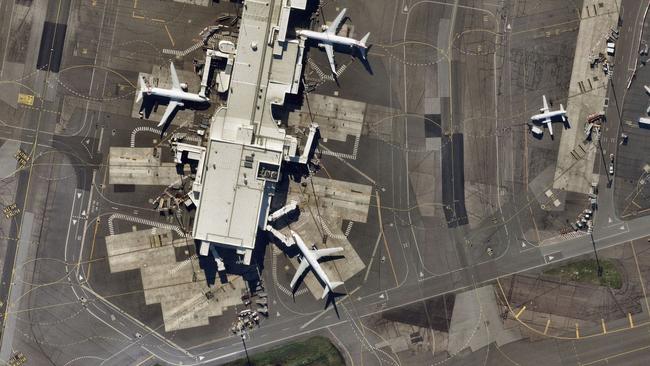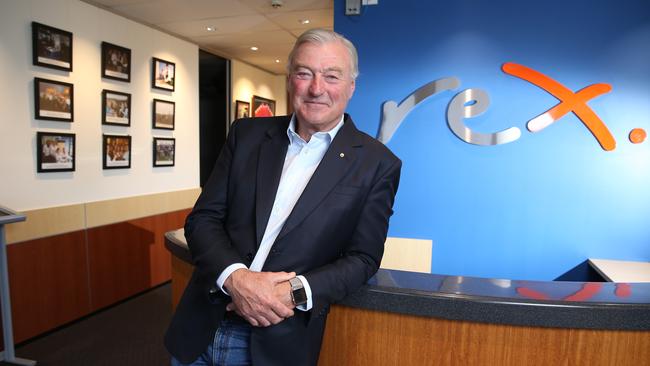Rex’s city foray runs into turbulence
The regional airline wants to take on Qantas and Virgin in the competitive capital city market. So far, many of its planes are running significantly below capacity.

Rex Airlines deputy chairman John Sharp has conceded passenger numbers on its capital city routes – the key to the company’s expansion plans – “aren’t where we want them to be” even as the carrier exits an increasing number of regional destinations.
But Mr Sharp said the company was committed to growing the capital city services, launched in March 2021 with six Boeing 737-800NG aircraft, and was yet to spend half of the $150m of funds invested in the expansion by private equity firm PAG Asia Capital.
Over four days, The Australian monitored passenger levels on 35 of 58 Rex flights between Sydney, Melbourne, Brisbane and the Gold Coast. The analysis shows many of those – tracked Monday to Thursday last week – had few passengers. Twelve, with fewer than 44 passengers, were less than one quarter full. One flight, from Sydney to the Gold Coast, appeared to have fewer than 10 passengers. Only three, two between Sydney and Melbourne and another from Melbourne to Brisbane, had more than 100 passengers.
Mr Sharp, who briefly served as transport minister in the Howard government, disputed some of the figures, and said a focus on just four days was “not an accurate reflection of what can happen in a week”. The airline’s busiest days were Friday to Sunday, Mr Sharp said, adding in that period aircraft were regularly full.
Rex declined a request to provide its own passenger data.
“This doesn’t come as a newsflash to us. We’re obviously aware of it and the numbers aren’t where we want them to be in the middle of the week,” Mr Sharp said of the figures compiled by The Australian. “They’re excellent Friday, Saturday, Sunday and Monday morning. Sometimes it’s difficult to get a flight on the weekends.”
For now, Mr Sharp said, the strong passenger numbers over those days were enough to keep the services – which have a capacity of 176 – flying.
“No one realises just how low cost our operation is yet we offer a full service experience for the passengers with all the things that Qantas offers,” said Mr Sharp.
“The only thing we don’t offer yet is a loyalty program which we will resolve fairly soon.”
“We haven’t touched the second half of the $150m we have available to us from PAG. It’ll take whatever time it takes to build and the domestic market is improving,” he said. “There’s a slow period in the middle of the week and that’s what Qantas and Virgin are also experiencing … reflected in the number of flights they cancel.”
In March, figures compiled by the Bureau of Infrastructure and Transport Research Economics show, the average load factor for all commercial passenger flights between Sydney and Melbourne was 78.4 per cent. It was 72.9 per cent between Brisbane and Sydney and 73.8 per cent between Melbourne and Brisbane.
Rex has high growth aspirations for its capital city network, and has previously said it expected to expand from six 737 aircraft to 14. It intended to fly to all capital cities in 2022, Mr Sharp told an aviation summit late last year.
While the Covid-19 pandemic pushed the aviation sector to the brink of collapse – and sent Virgin Australia into administration – Rex has benefited from significant government support. The withdrawal of the Regional Airline Network Support scheme at the end of June, however, has meant Rex will withdraw flights from Sydney to Grafton, Bathurst, Lismore and Ballina – and from Adelaide to Kangaroo Island. The airline has previously announced its intention to stop flying between Melbourne and Albury and Sydney and Canberra.
Rex’s expansion into highly-competitive city routes is being funded by PAG, which has been given two board seats and a 47.6 per cent stake in the airline in return. The six 737 aircraft were previously flown by Virgin Australia, and were secured at a low cost of $60,000 per month at the height of the pandemic. The leasing price will rise to $100,000 in 12 months.
However, many of the scheduled flights monitored last week by The Australian were cancelled. Despite plans to operate nine return flights a day between Sydney and Melbourne – the world’s fifth busiest route – Rex was currently flying just four. The Brisbane to Sydney route is down to return services most days rather than the intended three, and Melbourne to Brisbane is flown just daily midweek, with extra flights on Monday and Friday.
Peter Harbison, the chairman of market intelligence firm CAPA Centre for Aviation, said the low frequency of Rex flights made it an easy target for the larger airlines.
“Rex is selling seats on price, and the other carriers can easily match them on price at the particular times they fly even though their costs are higher,” he said.
“If you look at Webjet, you’ll see most of (Rex) flights are very carefully matched by Jetstar and Virgin which means they’re not really able to leverage the lower price thing to the extent they need to. As long as they have low frequency that’s a disadvantage.”
Another challenge facing Rex is a lack of brand awareness, Mr Harbison added. With a limited marketing budget, Rex had made little effort to announce its presence in the fiercely competitive domestic market and had no apparent point of difference, he said.
“Rex has got to do something a bit different. They’ve got to get known because very few people know that they fly,” he said. “If you want to get in a nice business class seat, it’s very cheap to fly that way (with Rex) but does anybody know that? You can fly business class on Rex for a similar price that other airlines charge for economy.”
Mr Sharp said the airline was aware it needed to increase the frequency of flights. “We are bringing in more aircraft as we can get them and getting them is more challenging these days than it was a while ago. It is doable, it just takes longer,” he said. “That’s what we always planned.”

Speaking in February after the airline posted a $36m loss for the six months to December 31 – down from a $10m profit for the same period one year earlier – Mr Sharp said Rex had signed “a number” of large companies and was making inroads into the business market.
According to the figures compiled by The Australian, 12 flights between Sydney and Melbourne were on average only around 39 per cent full. One Tuesday flight from Sydney to Melbourne had fewer than 30 passengers on board. Tickets on those flights were on sale for $121.
The cost of fuel alone on a one hour Melbourne to Sydney flight is estimated to be around $3800 – assuming Rex has hedged at least a portion of the cost. That does not include airport charges, aircraft lease fees and labour costs.
Tony Webber, a former Qantas chief economist who now lectures at UNSW, said there was a limited time any airline could operate a route with few passengers.
“Their owners won’t let it happen forever,” said Mr Webber. “I would say they probably underestimated the degree of competition in those Golden Triangle sectors. It’s a very aggressive, cutthroat industry, and Qantas especially will be very, very aggressive.”
Rex has repeatedly complained to the Australian Competition and Consumer Commission about Qantas and last week blamed its larger rival’s “predatory action” and “bullying and heartless behaviour” for pulling out of some regional routes. A Qantas spokeswoman said Rex appeared to have no problem investing in major city services, and described the airline’s claims as “far fetched”.
Mr Harbison said competition rules were not designed to protect airlines in the market, but consumers. “You could argue you’ve got Qantas, Jetstar and Virgin … I doubt that you’ll still be seeing $79 fares as often as you are, if Rex went out of the market,” he said.
Additional reporting: Kayla McLean




